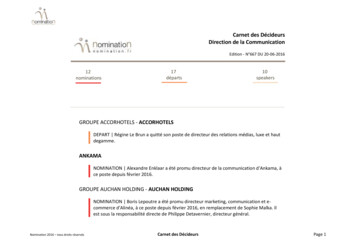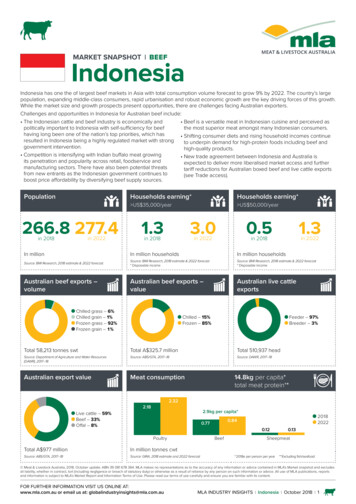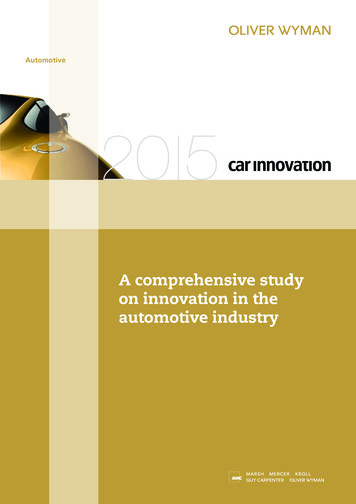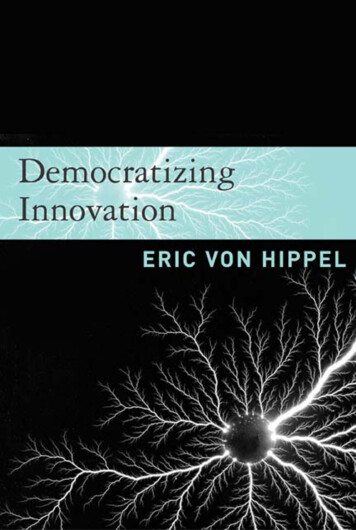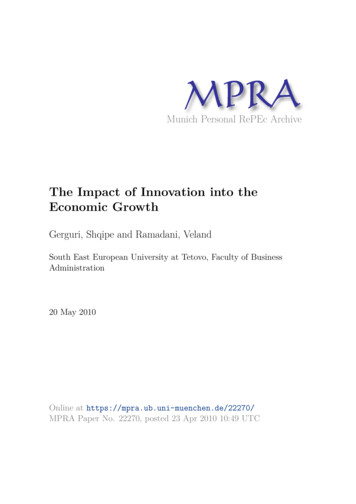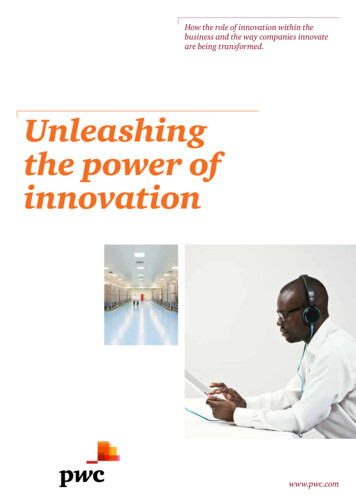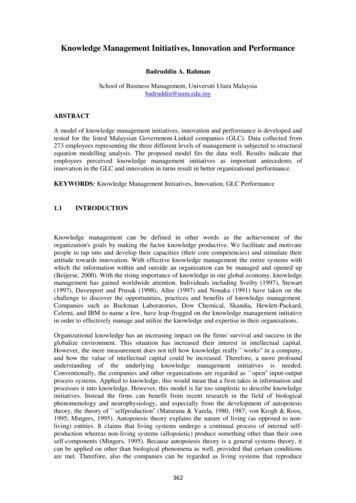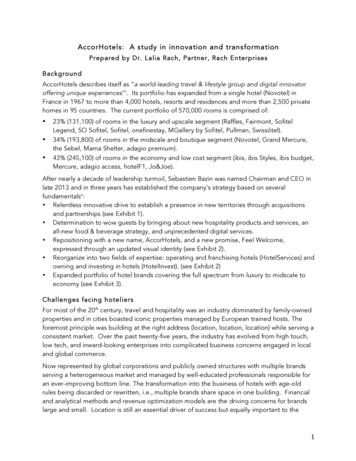
Transcription
AccorHotels: A study in innovation and transformationPrepared by Dr. Lalia Rach, Partner, Rach EnterprisesBackgroundAccorHotels describes itself as “a world-leading travel & lifestyle group and digital innovatoroffering unique experiences”i. Its portfolio has expanded from a single hotel (Novotel) inFrance in 1967 to more than 4,000 hotels, resorts and residences and more than 2,500 privatehomes in 95 countries. The current portfolio of 570,000 rooms is comprised of: 23% (131,100) of rooms in the luxury and upscale segment (Raffles, Fairmont, SofitelLegend, SO Sofitel, Sofitel, onefinestay, MGallery by Sofitel, Pullman, Swissôtel). 34% (193,800) of rooms in the midscale and boutique segment (Novotel, Grand Mercure,the Sebel, Mama Shelter, adagio premium). 43% (245,100) of rooms in the economy and low cost segment (ibis, ibis Styles, ibis budget,Mercure, adagio access, hotelF1, Jo&Joe).After nearly a decade of leadership turmoil, Sébastien Bazin was named Chairman and CEO inlate 2013 and in three years has established the company’s strategy based on severalfundamentalsii: Relentless innovative drive to establish a presence in new territories through acquisitionsand partnerships (see Exhibit 1). Determination to wow guests by bringing about new hospitality products and services, anall-new food & beverage strategy, and unprecedented digital services. Repositioning with a new name, AccorHotels, and a new promise, Feel Welcome,expressed through an updated visual identity (see Exhibit 2). Reorganize into two fields of expertise: operating and franchising hotels (HotelServices) andowning and investing in hotels (HotelInvest). (see Exhibit 2) Expanded portfolio of hotel brands covering the full spectrum from luxury to midscale toeconomy (see Exhibit 3).Challenges facing hoteliersFor most of the 20th century, travel and hospitality was an industry dominated by family-ownedproperties and in cities boasted iconic properties managed by European trained hosts. Theforemost principle was building at the right address (location, location, location) while serving aconsistent market. Over the past twenty-five years, the industry has evolved from high touch,low tech, and inward-looking enterprises into complicated business concerns engaged in localand global commerce.Now represented by global corporations and publicly owned structures with multiple brandsserving a heterogeneous market and managed by well-educated professionals responsible foran ever-improving bottom line. The transformation into the business of hotels with age-oldrules being discarded or rewritten, i.e., multiple brands share space in one building. Financialand analytical methods and revenue optimization models are the driving concerns for brandslarge and small. Location is still an essential driver of success but equally important to the1
bottom line are a consistent customer experience, variable pricing strategies and manipulationof distribution channels.The advance of technology has up-ended the buying process by placing the consumer firmly incontrol and providing in-roads for disruptors (online travel agencies and peer-to-peer shortterm residential lodging). Long-held, core principles of the industry are being challengedelevating decision-making based on a proper blend of analysis and information with gutinstinct and experience relegated to a minor role.Hotels in an Age of Disruption iiiThe hotel industry is grappling with ongoing consumer, technological, economic andorganizational change that Harvard business professor, Clay Christenson, views as a time ripefor disruptive innovation. Disruption, whether a result of technological advances or changingideas about an established product, service or organizational practice, can cause chaos orcreate opportunity within a business.When innovation changes thinking (guest room don’t need actual keys) or interferes withoutdated processes and norms (auditing no longer needs to be an overnight event), orchallenges the status quo (a phone can be mobile, no longer anchored to a desk) or playshavoc with traditional thinking (only one brand per building) it creates opportunities orthreatens potential. Generally disruptors are from outside the industry able to see gaps incurrent service offerings causing guest frustration and decreasing satisfaction. The disruptorwill not only see an opportunity but also will understand how a new technology could be usedto attract more customers, lower costs and/or provide increased convenience.In times of disruptive innovation, leaders must consider possibilities even if they sound absurdfor ignoring change can lead to loss of market share, revenue and control and may lead tooutright failure. Organizations that face disruptive innovation and accept that past and currentprocesses are not necessarily the roadmap of the future are far more capable of constructing abetter future.Travel, Technology and the Global M arketplaceA recent report by PhoCusWrightiv summarized the impact of advancing technology since the1960’s: “Over the past fifty years, the world has become increasingly interconnected, globaleconomies are intermingled, information flows instantaneously and more people than everbefore have the ability to travel. Globalization is spurring development in emergingeconomies, and a growing, upwardly mobile population of travelers is venturing abroad for thefirst time. By 2030, emerging markets will welcome 57% of international tourist arrivals,compared to just 30% in 1980.”The interconnectivity needed to meet the rising demand for travel is rooted in manytechnological advances but truly everything changed in 1996 when Microsoft Corporationestablished Expedia, the first online travel agency (OTA). From this an avalanche of disruptingstart-ups (Priceline, TripAdvisor, OpenTable, Airbnb) with new ideas about the availability oftravel information shifted the axis of power placing the buyer in the driver’s seat. For some2
within the hotel industry, it mimicked a bloodless coup. Business was caught unaware ascustomers took control of the keys to the kingdom with a keystroke rather than a sword. Thebelief hotels controlled information was so engrained in the psyche of the hotel professionalthat any notion that information would be available, transparent and immediate wasincomprehensible and threatened traditional and conventional thinking.Once buyers understood that technology was a means to an end, travel moved beyond therealm of possibility. In short order, ensuing innovations placed all aspects of the travel journeyin the palm of the traveler’s hand. PhoCusWright reports “The shift to online booking channelscontinues [with] a range of factors influenc[ing] growth rates in individual markets, includingonline penetration, technology infrastructure, credit card adoption and macroeconomicconditions. In mature online markets (U.S., Canada, Europe) where online travel penetration is45-50%, online growth has leveled. Emerging regions (Asia Pacific, Eastern Europe, LatinAmerica, Middle East), still have significant room for additional online booking gains.By 2017,all regions except Latin America will have reached or exceeded 35% online travel penetration.”Due to the multitude of channels available, it is increasingly a self-directed buyer journey thatoccurs in a non-sequential, non-structured fashion. Buyers’ aspirations are now based on aglobal experience rather than local norms (no more keeping up with your neighbors now weaspire to be like people we have never met). Each time a buyer engages, the individual orgroup contacted for advice may be different, depending on the desired product or experience.The ability to connect to seemingly endless possibilities has heightened the casual andimpromptu aspects of consumer nature in ways that challenge conventional thinking.Brief History of AccorHotels vThe very DNA of AccorHotels is awash in innovation, risk-taking and change. Beginning in1967 two individuals, Paul Dubrule and Gérard Pélisson, turned vision into reality by ignoringthe status quo. Combining knowledge gained while studying in America and recognizingchanges in the U.S. hotel industry stemmed from advancing consumer behaviors, the two menrewrote hotel development, design, marketing and service traditions long-held in France andthroughout Europe.The foundation of the company was Novotel, a three-star brand that broke with the past andestablished the modern hotel industry in France. Their first Novotel had a private bath in everyroom (unheard of at the time) and was located near the airport in Lille, France, a secondary citysome 140 miles from Paris. Subsequent builds were located on the outskirts of a city, alongroads or near airports, and featured unusual amenities and services such as a working desk, aphone with a direct outside line, a swimming pool, and free breakfast. By 1974 there were 45Novotels throughout France, with growth a combination of wholly-owned and franchise.Breaking convention again, the founders developed Ibis hotels, a two-star brand in the mid70’s. The chain was conceived as a simple solution for investors, franchisees and travelers.Using 30% as the baseline (rooms priced 30% less than Novotel, measuring 30% smaller thanNovotel and with 30% lower building cost than Novotel), all rooms had a bathroom but withouta bidet, a move that was consider improper for the time but a cost saving measure that3
acknowledged changing norms. To secure a positive future Ibis was built near an establishedNovotel, the first steps toward a customer-centric business strategy that addressed a broadspectrum of traveler needs. In 1984 the first one-star hotel brand in the portfolio, Formule 1,was developed and again broke tradition as it was designed to function without any employeesand quickly became the standard across Europe for low cost hotels.In the 1980’s recognizing that yesterday’s success did not secure the future, leadershipdecided to add a third growth tactic, acquisition of brands, to complement the existingmethods of ownership and franchising. The first major acquisition was the purchase of theSofitel chain, a move that expanded the portfolio into the upscale and luxury segment. Buyingestablished, successful luxury brands continues to the present with the purchase in July 2016 ofthe Raffles, Fairmont, and Swisshotels brands from FRHI Holdings.In current times the founders’ philosophy of consistent change to further growth has resulted ina reorganization into two divisions (see Exhibit 2):o HotelInvest. A real estate investment business focused on owning and leasing hotelassets. As of October 2016, the portfolio had 1,183 hotels with 87% located in Europe and 90%in the economy and midscale segments, and 2015 EBIT margin was 7.8%, nearly double of 2013.oHotelServices. An operating business specializing in managing hotel operations for bothAccor-owned and other-owned properties. The goal is to maximize fees, speed up CRM andloyalty-building drives, shift the group deeper into the digital realm, and roll out a strategy in eachsegment to bolster the brands.Described throughout the industry as an “asset-light” strategy, the reorganization frees capitalto redefine the business of AccorHotels and produced record profit in 2015 (see Exhibit 4).HotelServices has two strategies -- an expansion of branded hotels and private residences andthe advancement of technology capability to accomplish a digital transformation at every stepof the traveler journey -- which are the foundations of what the company will become.HotelInvest is to reposition the owned portfolio, reducing exposure to leases and generate newcapital sources. After completing the purchase of FRHI in July 2016, Bazin announced thetimeline for offering outsiders an opportunity to invest in HotelInvest’s share capital would beaccelerated. The project, designated “Booster” has a twofold purpose: to provide increasedfinancial resources to speed up growth in all areas of the company and to decrease ownershipof HotelInvest by AccorHotels to less than 50%.vi Ultimately HotelInvest will become asubsidiary.Building for tom orrowIn just five decades, AccorHotels transformed into a global corporation with a capacity forunearthing opportunities in compatible sectors, an essential element of the organization’ssuccess. Today horizontal and vertical diversification is being employed to incorporate newbusinesses to generate prolonged and dynamic growth (see Exhibit 1).Over the past three years, AccorHotels has employed horizontal integration by outrightpurchase of or investment in seven hotel brands (Mama Shelter, Raffles, Fairmont, Swisshotels,25hours Hotels, Huazhu Hotels and Banyan Hotels), one private residences brand (onefinestay)4
and two home rental platforms (Squarebreak and Oasis Collection). The ten additions extendtheir product offerings within the luxury midscale and economy segments, further theirdevelopment in China, and expand the organization into residential lodging.To further their digital strategy, the company purchased Wipolo, Fastbooking, and John Paulto vertically shift into related but different stages of the travel journey. The addition of thethree digital service companies provides the additional products and services needed to movebeyond the book and stay portions of the traveler journey. Wipolo is a mobile app thatprovides one-stop shopping allowing traveler to book flights, hotels, rental cars, and makerestaurant reservations and then manages their bookings. Fastbooking is a B2B online platformthat provides a website builder, a channel manager, digital marketing campaigns, andbusiness intelligence software. John Paul is a 21st Century concierge service that providesB2B2C service using advanced CRM and exquisite personalized service to secure a deeprelationship with guests by expanding the number and level of touch points.By rethinking and incorporating digital technology wherever and however it will strengthen theguest experience, improve services offered to investor partners and consolidate the company’sdistribution market share. The growth strategy is anchored by an infusion of digital capabilitiesaimed at the very heart of the organization’s transformation (see Exhibit 5). Expanded digitalcapabilities are necessary to success in:o Total guest engagement leading to an ownership position in acquisitiono Using OTAs as acquiring channel and learning channelo Expanded CRM activation and retentionRedefining the company included a transformation of identity accomplished through a namechange (from Accor to AccorHotels), redesigned visuals, and a new philosophy. The logo (seebelow) incorporates the Brent Goose and the philosophical tag line “Feel Welcome” with thenew name as the connection for all (guests, employees, franchisees, investors) across thebrands. The Feel Welcome promise, according to the company, captures the generosity andthe very essence of hospitality. It is a promise addressed to all our audiences: customers,employees and partners, so that they feel expected, unique and privileged. The identifytransformation enriches the bond between the company and its brands, linking all to the digitalplatform (accorhotels.com), the mobile app and the spirit and determination of employees.A Bold Vision: Taking on the disruptorsCEO Sébastien Bazin has gone “all in” and declared, “We will build the hospitality of the futurearound a bold and innovative vision of our businesses.” Further, in an interview with USAToday he claimed, “The digital space where you have seen the OTAs and Expedia andBooking and Kayak and Trivago and TripAdvisor and Airbnb and Google, I want Accor to5
participate in that field. Any new services provided to travelers--Accor should be thinkingabout it as either a partner or an acquirer.”viiWith the CEO proclaiming the organization will not sit on the sideline watching disruptors butwill actively take the offensive to fashion a stronger, more successful future. Bazin’s vision andstrategic plan are anchored by an unconventional, transformative and straightforward strategydescribed as “Leading Digital Hospitality”. It is designed to make AccorHotels “the world’sbenchmark hospitality player offering guests, employees and partners a unique experience”viii.To back up his words, the company has committed at least EUR225m (US 239m) over fiveyears, ending in 2018, to strengthen their digital capabilities and become more than a hotelcompany.ixThe centerpiece of AccorHotels digital strategy is an online marketplace offering travelers awide-ranging digital shopping experience that includes a select group of independent hotelslooking for wider access to potential guests placed along side Accor’s branded hotels. Thereason for creating the marketplace is to strengthen AccorHotels ability to control andcomplete the sale and to add value and reward loyalty. While taking an open, transparentapproach AccorHotels is becoming an intermediary, adopting a “if you can’t beat ‘em, join‘em” philosophy. In November 2016, it was estimated that the marketplace offered 6,000hotels and private residences of which one-third were independent hotelsx. The marketplace,an online distribution network, is available on the AccorHotels company website and theirmobile application. It is a major growth initiative and possible game-changer, aimed atbolstering the Group's position in the digital distribution landscape and adapting to moderntravelers' needs and time constraints when researching and booking accommodations online(see Exhibit 6).A recent article in tnooz.com stated that beginning in 2017 the platform would be available toindependent North American hotels with the objective to add 200 hotels in ten key Americanand Canadian cities.xi But being open does not mean standards go by the wayside. Multiplecriteria for inclusion in the platform must be met to be included in the marketplace:o The hotel must have a 3.5-star TripAdvisor rating if it is an economy hotel, a 4-star ratingif it is a midscale or upscale hotel and a 4.5-star rating if it is a luxury hotel;o The hotel must have sufficient rooms to make sense to add to the platform;o The hotel must pass an inspection conducted by AccorHotels.To strengthen the attractiveness to independent hotels the company is offering a better dealthan other OTA’s with commissions a third to half less -- 14% per booking if you are not acustomer of FastBooking and 12% if you are. The option to participate in Le Club, AccorHotelsloyalty program, costs a 5% per booking fee for the property.Bazin views the digital strategy as additive “ . [we are] not against the OTAs as they havegiven us customers we would not have got otherwise . We are happy to pay for the customer,but only once.” During an analyst presentation in November 2014 he went on recordindicating AccorHotels must reverse the direct-versus-indirect booking percentage from thecurrent 60/40 figure favoring OTAs. xii To date AccorHotels has decidedly expanded theirsphere of influence by at the very least thinking outside the box. Whether the company will be6
able to take full advantage of their innovative and revolutionary changes is yet to be answered.If the past is any indication, the desire to transform will propel the company to new levels ofgrowth and existence. A quote from 2015 Annual Report by Vivek Badrinath, Deputy ChiefExecutive Officer, Marketing, Digital Solutions, Distribution and Information Systems affirms thecommitment: “To reinvent digital hospitality, in 2015, we modernized our guests’ booking andhotel-stay experiences; equipped our teams with shared digital tools; streamlined relations withour partners, and launched innovative trials more than one thousand AccorHotels employeesworked on these issues. Our digital presence has been strengthened, and this is just thebeginning of our transformation!”xiiiRecognizing the need to disrupt their own thinking, Bazin established what he termed a“shadow Executive Committee” of managers between 25 to 35 years old who have worked atleast 5 years at AccorHotels. The rationale for the shadow committee is to inject diversity intothe thinking of the older senior executives who lead the organization, to bring the millennialpoint of view forward to leadership. The 13 members of the shadow committee are from allareas of the company operationally and geographically and were selected by the executivecommittee. The shadow committee receives targeted coaching and mentoring as theexpectation is for them to provide feedback on the agenda and decisions facing and made bythe actual executive committee. Each shadow member prepares recommendations on issuesfacing the board in a direct effort to change the mindset and culture of the organization. Bazinbelieves “The ability of these young people to predict the world of tomorrow is finer than ours.In particular on the subjects at the heart of the group’s current problems: the expectations ofnew customers in terms of services and, more generally, the customer experience.”xiv Thenewest AccorHotels brand Jo&Joe reflects the injection of diversity of thinking andengagement of younger employees in decision-making. It is an economy brand blendingaspects of private rental experience with the hostel and hotel frameworks. A recent pressrelease describes the brand as “ the properties will include the bar will focus on a flagshipproduct (wine, beer or cocktails), with a unique selection promoting local and craft products;local, affordable craft cuisine and restaurants with a grill, open flame barbecue, wok or woodfired pizzas; the collaborative kitchen, where guests can cook meals; and The Happy House, aprivate area to relax, work, cook or wash clothes. Room types vary: "Together," the essence ofthe brand, offers a modular sleeping area guests share [with] beds, private lockers, readinglights, USB ports [and] access to shared recreation areas and bathrooms. "Yours" is rooms andapartments for two to five people with a private bathroom and a kitchen space. "OOO!" (Outof the Ordinary) accommodations for people traveling alone or in groups of up to six people.These original formats include yurts, hammocks and caravans. Rates start at 28 a night.”xvRecognition by outside organizations is one of the better indications of the success. Each year,Fast Company, an online business magazine, identifies the most innovative companies in theworld that tap heartstrings and purse strings and use the engine of commerce to make adifference in the world with impact as the key criteria. In the February 13 issue, AccorHotelswas included as one of the most innovative travel companies because it “is breaking out of theshadow cast by its larger rivals by building a portfolio of bold—and boldly differentiated—brands”.”xvi7
Exhibit 1 Far-reaching Growth Strategy (source: pressroom.accorhotels-group.com/en/), accesseddaily from 12/23/16 01/03/2017). Note: AH AccorHotels2014Vertical Acquisition Mama Shelter (French boutique brand, creates & choreographs lively accommodation & restaurantfacilities) Cost: Undisclosed, 35% ownership. Purpose: AH expand & enrich its offer with a differenttype of hotelHorizontal Acquisition Wipolo (a web & mobile platform, lets users plan trips - booking flights, hotels and restaurants, toshare information about their trips, manages trip itineraries, linking them with Facebook & Twitter).Cost: Undisclosed. Purpose: Provide users with seamless & mobile buying journey. Enrich AH mobileapp with new services managing every aspect of a trip, like a personal assistant.2015Horizontal Acquisition Fastbooking (provides digital solutions to independent hotels to increase their direct sales viaelectronic channels) Cost: Undisclosed. Purpose: To accelerate the implementation of AH digitalstrategy. Booking engine, distribution manager, GDS, optimization tools, traffic acquisition.Vertical Acquisitions FRHI (luxury and upscale brands Fairmont, Raffles and Swisshotels). Cost: US 2.9B ( 840M cash,remainder in stock to Qatar Investment Authority (10.5% equity stake) & Kingdom Holdings (5.8%)).Purpose: Accelerate transformation & positioning of hotel portfolio & geographic footprint as aleading player in luxury hotel market; & enhance luxury as a key part of strategic plan. Huazhu Hotels (hotel management company) Cost: No cash. AH 10.8% stake in Huazhu & Huazhu29.3% non-controlling stake in AH. Purpose: Strategic alliance to accelerate development of AH midscale & economy brands in China & combine loyalty programs & dual-platform distribution system.Annual target of 50 economy and mid-scale hotel brands for ibis, ibis Styles, Mercure and Novotelacross mainland China under Huazhu alliance over the next three years. Banyan Hotels (operator & developer of premium 43 hotels/resorts, 64 spas, 77 retail galleries, threegolf courses in 28 countries.) Cost: US 16.5M Provides a 5% stake in Banyan, option of 5% more.Purpose: Complement current luxury offerings especially in Asia. Partnership to develop & manageBanyan Tree-branded hotels around the world. 25hours Hotels (individual, design-oriented boutique hotels primarily in Germany) Cost: 30% stake.Purpose: To add another product thereby furthering “cradle to grave” strategy. Onefinestay (London-based high-end residential rentals offering a hotel-like service, more than 2,500properties) Cost: US 170M with additional US 70M to be invested over next 5 years. Purpose:Expansion into vertical - private rentals for high-end stays. Follow clients’ needs to remain relevant. Oasis Collections (digital platform offering apartments & personalized services to leisure & corporateguests) Cost: undisclosed sum. 30% stake. Purpose: Provide complement to upscale brands. Squarebreak (upscale French villas-resort-hotel digital platform) Cost: undisclosed sum. 49% share.Purpose: With onefinestay, Oasis Collection realizes leadership position in luxury residential rentals.Horizontal Acquisition John Paul (high-end worldwide concierge service firm with proprietary CRM software application andmanagement platform) Cost: US 150M. 80% stake. Purpose: Further strategy of placingcustomers at the center of everything & to generate new revenue streams from services.8
Exhibit 2 Guiding Principles (source: Adapted from AccorHotels’ Strategic Vision tegic-vision.html, accessed 12/20/2016)W e express our personality through a strong identity. Two words “Feel Welcome”expresses and positions the Groups greatest strength: its passion for hospitality and for the hotelindustry professions.W e bring complem entary fields of expertise into play. To ensure its long-termexpansion, AccorHotels re-organized in 2013 into two separate divisions: HotelServices Division (operation and franchising) 4,100 hotels/570,000 rooms operating underthe Group’s 19 brands. Mission is to manage hotel operations and provide the best choice ofservices for partner hotel owners including a powerful distribution system. 67% of hotels arefranchised and 33% are under management contract. HotelInvest Division (ownership and investment) mission is to streamline and manage theexisting asset portfolio through disposals and acquisitions based on three criteria: margin, cashgeneration and location. The goal is to establish the leading hotel investor in the economy andmidscale segments in Europe, focus on cash-flow generation and reduce result volatility, optimizeCAPEX allocation strategy and support AccorHotels’ development by investing selectively inproperties.W e leverage innovation to increase our operational excellence. Uses significantdistribution clout to offer distribution and digital services to partner hotels. With 329 million visits a year,AccorHotels.com is now open to independent hotels. Le Club Accorhotels (loyalty program) is free ofcharge, covers every Group brand and every country worldwide, and boasts around 25 million members.W e think big when it comes to the Group’s developm ent. Our development strategyhas two main fronts: cementing the Group’s leadership in Europe and swiftly developing its presence inemerging countries. Still significant growth potential in Europe, especially in economy hotels due to lowpenetration rates in many countries. Increase our presence in emerging countries in general and in highpotential countries such as Brazil, India and China in particular. The Group is leveraging its expansion by: Investing selectively in high-margin projects in prime locations, especially in the economy segmentin Europe Ramping up franchise development in the midscale and economy segments Harnessing external growth opportunities thru partnerships or acquisitions to consolidate theGroup’s leadership in the most attractive markets with asset-light operations.W e develop our in-house talent. With an active training program, the Group has more than170 courses and an 18-strong Academy global. Building professional management skills (encompassingrevenue management) and sales skills and shaping the jobs that hotels will need tomorrow, creating newbusiness lines, and building a pool of professional talent that will keep us in the lead on the market.W e reinvent hotels sustainably. Sustainable development and solidarity are key priorities forAccorHotels. PLANET 21 is taking its sustainable development agenda to the next level by establishing21 commitments, with specific targets that every hotel will be required to achieve this year.9
Exhibit 3 AccorHotels by Brand* (source: www.accorhotels- ‐group.com/en/brands/brand- ‐portfolio.html,accessed 01/02/2017)*In September 2016, the launch of a new brand, JO&JOE to round out the economy-brand portfolio,providing a made-to-measure solution for the Millennial-minded. To be developed in 50 city-centerlocations close to public transport and major points of interest.Exhibit 4 AccorHotels Financial Results(source: 2013 Business Review. www.accorhotels-group.com/
The goal is to maximize fees, speed up CRM and loyalty-building drives, shift the group deeper into the digital realm, and roll out a strategy in each segment to bolster the brands. Described throughout the industry as an "asset-light" strategy, the reorganization frees capital
